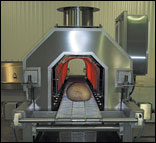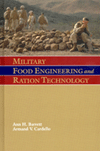

The system used by that processor was conceived by David Howard, a onetime business studies student at Northeast London Polytechnic who migrated from the medical supplies arena to the UK’s food equipment business. The Northern Ireland native founded Unitherm Food Systems Inc. in 1987 and moved operations to Bristow, Okla., seven years ago.
Working with staff engineers, Howard conceived, designed and built a hot-water submersion unit to pasteurize deli meats. Dubbed the Aquaflow, the first unit was installed at Plainville Foods in upstate New York in 1996. Independent validation studies conducted at Oklahoma State University have consistently found 2 to 4 log reductions of deli meats inoculated with Listeria monocytogenes, confirming the lethality of the submersion process as a post-packaging intervention. Howard recently spoke with Food Engineering about Aquaflow and some of the other food safety innovations he has devised.
FE: How does the water-emersion system work?
Howard: The unit itself is about 20 feet long and 8 feet wide and fabricated from stainless steel. Packaged product enters the unit in single file. A pushing mechanism arranges items six pieces across in a flighted area. They are conveyed through in two to two and a half minutes. Product is made somewhat buoyant by the water that is being constantly recirculated through a heating element and back into the tank through quarter-inch orifices on the bottom at a rate of 1,800 gallons a minute. It’s like a Jacuzzi, with the water highly pressurized.
I come from a nation of bathers, and anyone who has taken a bath knows that bath water does not retain even heat; it stratifies into different temperature zones. To get the product’s surface to 180° F, water is pumped aggressively so heat is delivered to the entire product. You get temperature uniformity the minute you start mixing water.
FE: Why do you use a tank of water instead of steam or a hot-water deluge?
Howard: I used steam to extend the shelf life of ready meals in England, but those products usually were consumed within three days. Deli meats have a 45-60 day shelf life, and pasteurization can extend that to 90 days, so the process must be thorough. I give the example of a 20-ft. long room with a door at either end. If you challenged someone to sprint through that room when it was filled with 200° steam, that person would be burned and need medical attention when he reached the second door, but he’d be alive. If there was a torrent of water in the room, he’d need more medical attention, but there would be patches on his body that were unaffected. But if the room was filled with scalding water, every orifice of his body would be burned, and there’d be a coffin waiting for him.
FE: How does a processor validate lethality?
Howard: Probes measure and record water temperature at three different points along the unit’s bed to generate a document that shows that thermal stratification didn’t occur. The data are stored and become a part of your HACCP documentation. In the event of a boiler failure or some other hot-water interruption, the infeed to the tank closes down if the water temperature drops below 190° so that additional product can’t be run.
How a processor manages the risk analysis of failure is critical. If you have a recall, the first thing FSIS wants to know is, how do you prove your protocol worked? Lab tests have validated 3 log reductions in various products at a given time and temperature; risk analysis is all about knowing what can go wrong and documenting what you do to make sure protocol is met.
FE: How have ready-to-eat processors responded to Aquaflow?
Howard: Nine units have been placed into service since 1996. The system costs $750,000; when you add in site preparation, it could be a $1 million project. If capital cost was neutral and plant space was not an issue, processors would opt for in-bag sterilization. But money and space are issues, and sometimes the choice is do nothing or try a less expensive process. That’s why we developed a radiant heat oven, which costs $75,000. The first infrared unit went into service in December 2000. Today there are 17 in use.
FE: How does the radiant heat oven work?
Howard: The unit is about 13 feet long and 20 inches wide. It replaces a section of a conveyor that takes product to a bagger, so the footprint doesn’t really require any additional space. The infrared heat element operates at 1,200°F. It’s comparable to a grill. Deli products typically are in the 30 to 40° range, and at that temperature the oven delivers good surface lethality. One study involving roast beef showed a 3.6 log reduction in Listeria based on 60 seconds residence. If product entered frozen, I’m not sure infrared would be the right solution.
Product exits the unit on a stainless steel chute coated with AgION, an antimicrobial compound, and then into a vacuum bagger. The only opportunity for contamination is from the operator and the bagger. Operators usually are outfitted in a mask and gloves, but if you audit them you typically find that they use one pair of gloves a day, even after going to the cafeteria for breaks and lunch and to the rest room. That’s why we mounted an alcohol-based hand sanitizer on the end of the unit for those operators. Attention to detail gets you results, and a $300 sanitizer might eliminate that one time in a million when you have cross contamination.
FE: Why use infrared rather than another heat source, such as microwave?Howard: There’s no guarantee of uniformity with microwave. The waves aren’t controllable, so longer exposure time is required. As a result, energy penetrates up to 2 inches into the product, which means more energy has to be taken out later. With infrared, the surface is heated to a very high temperature very quickly without changing the internal temperature. The surface is where the possibility of cross-contamination exists.
FE: How much cost does steel with an antimicrobial coating add?
Howard: You’re talking less than $30 additional cost to coat the chute. We’ve been working with AK Steel, which is the licensee for that antimicrobial coating. We’ve also incorporated it into our floor drains. Drains are a major source of Listeria in meat processing, and you create a two-way directional hurdle for the pathogen by coating traps. The material cost is insignificant, about $5 per drain. Antimicrobial coatings could be a great benefit to the industry.
FE: How does the industry view post-pasteurization?
Howard: Every processor of ready-to-eat meats has investigated pasteurization in the last three years; 70 percent of them have taken a wait-and-see position until USDA requires some kind of intervention. At the larger companies, food safety tends to be departmentalized, and the people who are reviewing the chemical interventions and process options are not the same people who make the business decisions. The chain of command is more direct at smaller companies, so they tend to take the lead in safety innovations. An example is Stevison Ham Co., which started using the radiant heat oven last fall.
FSIS now has the tools to catalogue the DNA fingerprint of any pathogen they find. There’s no reluctance on their part to trace it back to a plant and say, “You are the contaminator, and here is the proof,” and then shut that plant down. Next-generation technology will increase their ability to genetically isolate a bug by a million-fold. Processors are going to have to prove they are controlling risk, and pasteurization is one of the hurdles they can use.

